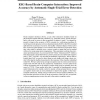Free Online Productivity Tools
i2Speak
i2Symbol
i2OCR
iTex2Img
iWeb2Print
iWeb2Shot
i2Type
iPdf2Split
iPdf2Merge
i2Bopomofo
i2Arabic
i2Style
i2Image
i2PDF
iLatex2Rtf
Sci2ools
NIPS
2007
2007
EEG-Based Brain-Computer Interaction: Improved Accuracy by Automatic Single-Trial Error Detection
Brain-computer interfaces (BCIs), as any other interaction modality based on physiological signals and body channels (e.g., muscular activity, speech and gestures), are prone to errors in the recognition of subject’s intent. An elegant approach to improve the accuracy of BCIs consists in a verification procedure directly based on the presence of error-related potentials (ErrP) in the EEG recorded right after the occurrence of an error. Six healthy volunteer subjects with no prior BCI experience participated in a new human-robot interaction experiment where they were asked to mentally move a cursor towards a target that can be reached within a few steps using motor imagination. This experiment confirms the previously reported presence of a new kind of ErrP. These “Interaction ErrP” exhibit a first sharp negative peak followed by a positive peak and a second broader negative peak (∼290, ∼350 and ∼470 ms after the feedback, respectively). But in order to exploit these ErrP...
| Added | 30 Oct 2010 |
| Updated | 30 Oct 2010 |
| Type | Conference |
| Year | 2007 |
| Where | NIPS |
| Authors | Pierre W. Ferrez, José del R. Millán |
Comments (0)

